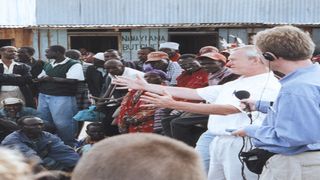
Martyn Day addressed a crowd during his fact-finding mission in Kenya in 2002.
| PoolPremium
Lawyer's journey to legal glory for victims of British Army explosives
What you need to know:
- Local people were paid a total of Sh450 million for losing relatives and sustaining serious injuries from explosives left by the British Army.
- Another 1,000 were compensated in a further round of claims.
Before Martyn Day arrived in Kenya in 2001, his firm had become famous in South Africa and Swaziland, where he negotiated group claims on behalf of asbestos mine and mill workers against multinational companies in the UK.
Aware of the numerous cases of people who died as a result of explosions in Archer’s Post in Samburu East and Dol Dol in Laikipia North, international NGO ActionAid approached Mr Day, who was known for winning huge compensations for tens of poor people from some of the world’s richest companies.
The British Army had allegedly left unexploded ordnances in unfenced grazing fields, and more than 500 herders, mostly children, had died after picking up the explosives or accidentally stepping on them.
“Immediately they approached me, a colleague and I jumped on a plane to see the situation for myself and it was clear that there was a pressing problem with the lack of clear-up of unexploded munitions left on the Maasai and Samburu grazing lands adjacent to the towns,” Mr Martyn Day told Nation via mail.
A problem
When they arrived, a local organisation, Osiligi, which was already trying to pursue the Kenyan government over the undetonated explosives agreed to work with the lawyers, who were convinced that there was a problem. That marked the beginning of more than 20 trips to Kenya by the lawyers in the case that would last four years.
The lawyers Osiligi, led by Johnson ole Kaunga, started identifying the victims and assessing the nature of their injuries, with the help of several doctors. After the fact-finding was complete, Mr Day and his fellow lawyers returned to Britain to file a case against the government’s Ministry of Defence.
In the summer of 2002, a few members of the Maasai and Samburu community travelled to London to represent the victims during the mediation with the Ministry of Defence. The trip was sponsored by the Leigh Day law firm. The claimant lawyers made a breakthrough thereafter, and in 2002, the Defence officials in London agreed to settle the claims without admission of liability on the basis that it left unexploded weapons in the training areas, but for the fact that it trained on unfenced grounds.

Martyn Day chats with munition victim Kipise Louroilkeek outside the Houses of Parliament in London in 2002.
Finally, 230 people were paid a total of Sh450 million for either losing a relative, or sustaining serious injuries that resulted in disability due to loss of limbs. Another 1,000 were compensated in a further round of claims.
The entire litigation faced significant evidential challenges, among them, language barrier and logistical difficulty travelling the vast ranges to meet clients and get them medically assessed.
“Virtually all the deaths and injuries suffered had occurred long before we were instructed and there were no remnants to examine of the particular munitions which had caused each explosion.
“We had to rely on people’s accounts of what had happened and the British Army’s records. We did not get much assistance from the Kenyan Government at the time, in terms of their records – and as the cases progressed it seemed clear that the Kenyan Army also practiced in the same ranges, so differentiating between munitions left over by each army became an issue,” said Mr Day.
There were no death certificates for those who had died, and the claimants had to rely on the accounts of village elders, whose integrity the British Government sought to undermine.
“A particularly heart-wrenching task was differentiating those people — often children — with burns and injuries caused by munitions from those with injuries from other causes, which we did with the help of medical experts,” added Mr Day.
65 percent
When finally the UK agreed to take 65 percent responsibility, the compensation was held in the UK until the minor claimants were 18 years old.
The second group of claimants received a smaller amount, as it had become clearer by then that a significant proportion of the unexplored ordnance was Kenyan. Also, differentiating as to which clients had been injured by British Army ordnance rather than Kenyan became very difficult.
Although some of the beneficiaries used the money to get medical treatment including corrective surgeries and acquiring prosthesis, a visit to Archer’s Post last week revealed that some of them did are now languishing in poverty.
The next time Mr Day handled a Kenyan case was during the litigation for the Mau Mau where the Leigh Day firm brought a case for over 5,000 claimants. The case was settled in June 2013, and the claimants obtained compensation and a statement by William Hague, the then British Foreign Secretary in Parliament – regretting that thousands of Kenyans had been subjected to torture and other forms of ill-treatment in the hands of the British colonial administration in the 1950s.
The construction of a memorial in Nairobi to the victims of colonial era torture, unveiled in September 2015, was also part of the settlement.
Currently, the Leigh Day law firm is acting for around 80 Kenyans who live close to Kakuzi PLC’s agribusiness operations in Murang’a County and claim they have been mistreated by Kakuzi’s security guards – including of rape and unlawful killing.





